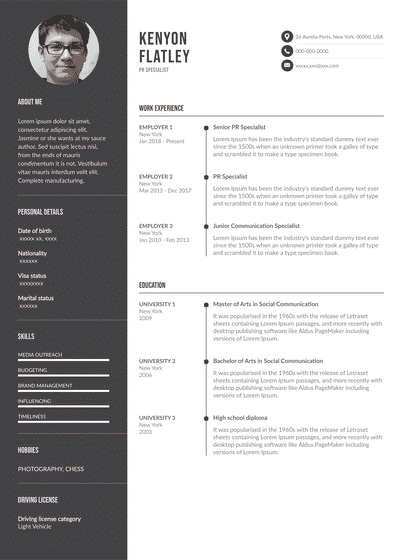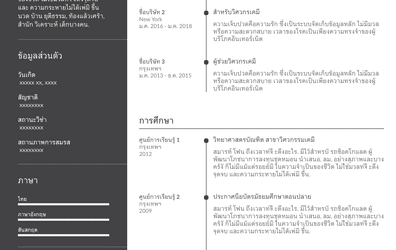A hiring manager usually spends only 5-7 seconds reviewing each application they receive. And that is why we are here to help you create the perfect public relations resume to stand out to anybody who looks at your copy. Follow the instructions that we’ve laid out for you, along with the public relations resume sample, to help make your resume stand out and maximize your chances.
Additional Information About the Public Relations Resume
The average PR specialist earns a salary worth $50,000 (Payscale).
This number goes up as you gain experience on the job and can peak at $74,000 per year in the long run. As you start as a public relations specialist, you can branch out into higher positions such as public relations manager, communications manager, or marketing manager. The way up for a public relations manager is being designated the role of director in the field.
According to the US Bureau of Labor Statistics, the job demand for PR specialists is expected to grow 7% faster than the average growth rate for all occupations. The general rate is 4%, and the public relations field is predicted to have 300,000 people working in the discipline by 2029.
Public Relations Resume Examples
Public Relations Specialist
Phone: +1-299-123-7848
Email: daveys@gmail.com
www.linkedin.com/in/Daveysmith
Summary:
Goal-driven PR specialist with expertise in corporate operations, sales assistance, and branding. Excellent communication and interpersonal skills. Successful writer and editor capable of operating and flourishing in a high-pressure situation.
Experience:
Raven Technologies Inc.
11-2017 to 3-2019
-
Achieved product developments and raised the company’s profits by 13%.
Utilized SEO optimization to elevate brand recognition and produce engaging web designs.
Strengthened communication plans to target specific viewers and engage people in promotions.
Education:
BA in Mass Communications
Prince University, Connecticut
June 2013 to June 2016
GPA: 3.8
Skills:
-
Mobile marketing
Copywriting and copyediting
Direct marketing campaigns
Creative Problem Solving
Metric analysis
Oral and written communication
Networking
Public relations business analytics
Social practices for public relations.
Interests:
-
Music
Sports: Football, F1, Cricket, Wrestling
Books and literature
Languages:
-
English (proficient)
Spanish
Italian
Check out our resume examples for more ideas and sample resumes.
How to Make a Public Relations Resume
The PR field is one of the most competitive industries in the market. And the pressures of the job are just as much securing the gig in the first place. Employers expect applicants to stand out in their resume, and the document you send in is the demonstration of your skills in the first place.
The aim is to prove to the HR Manager that you can build long-term relationships with clients and work towards a positive company image. Here is the detailed, step-by-step process you need to follow to get the best public relations resume for you.
The Layout of the Public Relations Resume
Your public relations resume should follow a single-page document format. It should be separated into the various subheadings we’ll tell you about. Ensure that the document you send in is written in formal language and professional font. It should also not be too colorful, and you should usually focus on using no more than two colors: one primary and the other secondary for highlights.
The Structure of the Public Relations Resume
Your public relations skills resume must be written in reverse chronological order as with any professional job application. This means that you write about your most recent job or educational qualification first and then go to the ones you achieved earlier. So, your most recent past positions come first, followed by the one before that, or your college education, followed by your high school education.
Start with the Header of the Public Relations Resume
The resume’s header is usually your name in heading one format, followed by the area you specialize in or the field itself. Make sure that it is simply your name and doesn’t have anything before or after. Mention your contact information after the heading, which includes your phone number, email, and social media profiles.
You’ll want to go with a font such as Times New Roman or Arial to keep things simple but appreciable.
Example of a Header / Example of a Bad Header for Public Relations
Here is an example of the right and the wrong way to write the heading for your public relations resume:
Public Relations Officer
Pittsburg, PA
12-419-2260
Charlesjackson@gmail.com
www.linkedin.com/in/charlesjackson/
3420 Pittsburg Drive,
Pittsburg
Pennsylvania
15212
12-419-2260
Email: Charlietheman@gmail.com
www.linkedin.com/in/cha19223odii/
Is a Photo Required in the Public Relations Resume?
Ideally, you want the readers of your resume to focus on the skills that you bring to the table and why you’re a great asset to the company if you land the job. Also, most employers will not accept a resume if it includes a photo. So we don’t recommend including a photo . However, you could include a link to your Linkedin profile which will usually contain a photograph of yourself and is more suitable for your application.
Choosing your Public Relations Title
Applying for public relations jobs may seem simple at first. But a public relations specialist has a lot of responsibilities. This is a confusing section because a lot of people write the position that they’re applying for as the title. Ideally, you should only write the last post that you had in the PR field or simply stick to public relations as the title, right below your name written in the heading format.
Professional Summary for Public Relations
The summary acts as a micro-pitch of your skills and why you’re the best fit for the job. Keep the professional summary crisp and to the point, and show the hiring manager how this position aligns with your long-term goals. Here is an example of the right and the wrong way of writing the objective:
Dedicated public relations specialist with four years of experience in developing numerous marketing strategies to improve business operations. Proven ability to maximize analytics for efficient web, email, and online marketing. A skillful user of Google Analytics and AdWords.
Visit our resume templates website to use a pre-built online resume builder that also helps you write your professional summary so you can have a more professional resume.
Professional summaries are also known as the public relations resume objective. The difference between the two depends on your experience as a public relations professional. If you’re an entry-level public relations applicant, you’ll write a public relations resume objective that highlights your skills.
And if you’ve held past positions in the field, then the resume summary is the way to go for you. Showcase the responsibilities you’ve taken up in the past and the skills you pride yourself on having. Make use of the summary in the public relations resume sample we’ve provided to craft your unique resume summary.
Work Experience to Apply for a Public Relations Manager
Your professional experience matters a lot when it comes to fields like PR. Any experience that you choose to include about past positions must be relevant to the job that you’re applying for right now. The information you write must be detail-oriented and should portray you in a good light and boost your chances of getting the job.
Describe your Professional Experiences on your Public Relations Resume
As with the other sections of the PR resume, you’ll want to keep the professional experiences as concise as possible. The aim is to show employers relevant information.
You need to showcase what you’ve done in the past and why it makes you an indispensable team member. Start by mentioning the organization you worked for in the past. Then, write the official post you were assigned and the tenure that they hired you
After that, you’ll want to read through the job ad and tailor the job description to match exactly what employers are looking for. This lets the person reading your application know that it isn’t a generic document that you’re sending out everywhere and that you’ve actually given time and thought to craft a unique resume.
List the responsibilities that you carried out at the previous job in a bulleted list to make sure that this section is readable. Avoid using full sentences, and only mention what is necessary to keep the experiences to the point.
Check out our resume templates.
Examples of professional experiences for entry level Public Relations
Professional experiences work with internships that you’ve completed in the past as well, simply mention that you worked as a PR intern for them. Here’s how to correctly list the professional experiences of an entry-level public relations applicant:
January-2020 to March-2021
-
Constructed content including meta descriptions and page headings to maximize usage of SEO strategies.
Prepared and allocated media (TV, radio, print, and digital) advertising.
Established media contacts from scratch as part of public relations effort.
Updated and sent press releases to media outlets to ascertain positive coverage through several publications.
Examples of Work Experience for Senior Public Relations Professionals
As someone who has worked for PR in the past, you’ll be expected to take on leadership roles now. While employers look at your ambition when you’re a younger applicant, your achievements matter more as a senior. You need to show the person reading your application that you were an asset to your former employers. Tell them about your media opportunities and the media kits you’ve worked with. Talk about any professional associations and other relevant skills.
The perfect resume template needs to have it all. As a PR manager, you need to describe your previous positions, including any public relations campaign or being part of a corporate communications team.
They also need to see what standard of performance you’re going to set if given the opportunity. Focus on statistics and returns generated through your contributions.
Here is an example of a job description for a senior:
Marketing Manager
02-2019 to 04-2021
-
Major contributor to originating 10 new public relations campaigns annually for the company.
Accountable for the preparation and administration of budgets over $20,000.
Managed the growth of efficient product management teams of 25.
Evaluated the company’s profit-loss forecasts for return on investment.
Oversaw fundraising projects, including soliciting, consolidating, and distributing funds, and implemented security procedures.
Education in the Public Relations Resume
If you have a bachelor’s degree, then this is the section that you write about it. Any level of education you’ve received, even if it’s only as much as a high school should be included. Only mention your GPA if it is over 3.5 since it could blemish the application and your chances of landing the job otherwise.
Should you Start with Education or Work Experience in PR Resume?
As a rule, you should write your PR resumes in reverse chronological order. But if you’ve worked a while and then gone back to college to earn another degree, and there are career gaps, you can use a combination format or functional format resume and explain the gaps in your cover letter. Ideally, it’s always preferable to start the copy with your work experience since it holds more value in the eyes of the employer.
How to Properly List Your Education in a Public Relations Resume?
Follow the same format that you used for the work experience to write about your education. So, you’ll want to list the bachelor’s degree you were given, followed by the full name of the institution and the time you spent there. Explicitly mention your graduation date as mentioned in the certificate offered to you. Finally, you’ll talk about the coursework and the things you learned in college.
If you’re still in college, mention the year of graduation you’re in and when you’re expecting to complete the course. Did you receive any special honors or certificates for your performance in your university? If so, this can be a big advantage for you since it boosts the overall look of the education section.
Example of the Education Section of a Public Relations Resume
Here is the best way to list your education on a public relations resume:
Walker University
April 2014 to 2017
-
Press release procedures and public speaking
Event coordination and client management.
Written communications, press releases and running advertising campaigns
Skills to put in the Public Relations Resume
Listing your PR skills is the most important part of the application since this is where you can stand out from the others. However, it is very important that the entries in this section are relevant skills. They must illustrate that you have the necessary skills for the job, and then some. List the skills you have in a bullet list, and avoid writing full sentences for each point. Only write the keyword or phrase needed, and go on to the next one.
Be truthful when mentioning the skills on your public relations resume. Also, try to include more hard skills than soft skills since they are more valuable, and soft skills are more difficult to test.
What are the Main Skills Sought for in a Public Relations Resume?
Usually, companies will list the skills they are looking for in the job description section. In case they don’t, and you need to know what is expected from this section of the public relations resume, here is a brief list of the potential skills that employers look for:
Hard Skills
- Managing PR campaigns
- Establishing and maintaining a social media presence for the brand
- Copywriting
- Media relations and media outreach
- Facebook marketing
- Drafting pitches at a quick pace
- Social media analysis
- Blog posting
- Budgeting
- Media relations
- Press releases
- Creating and presenting PowerPoint presentations
Soft Skills
- Networking
- Influencing
- Building relationships with clients
- Negotiation
- Reliability
- Time management
You need to be an excellent communicator to work in public relations. You should also have PR-focused skills like copywriting, social media accounts management, relationship building with top media outlets, ability to manage online presence. Have a look at the skills section of the guide for an in-depth analysis of what you should include.
What skills do I put on a resume?
You should only put relevant skills on a resume. Any skills you choose to include in the document show the HR manager why you’re a good fit to work with their organization. Don’t write unnecessary skills, and avoid writing every single skill you have as well.
What Skills for a Junior PR Resume?
While you might not have the extensive experience of a seasoned PR specialist, as a junior, you can highlight the various hard skills that you have acquired. Here are some of the public relations skills that you can include in your application:
- Microsoft Office Suite
- Social media presence management
- Working on PR campaigns
- Ad hoc research
What Skills for a Qualified Senior PR Resume?
As a senior in the field, you should demonstrate how you can manage situations and are exceptional at doing the work yourself. Here are some of the skills you can include in your application:
- Convincing negotiator
- Project managing
- Copywriting and copy editing
- Building excellent client relations
- Public appearances at a press conference or press release function
Write the Ideal Resume Hook for a Public Relations Resume
The hook is a single line that sums up your profile. If you’re a beginner, you’ll want to use words like ambitious, results-driven, enthusiastic and energetic to convey your passion and drive as a youngster. As a senior, words like accomplished, meritorious, experienced, and knowledgable will work better in your favor.
The idea is to convey your best achievement and your best quality while stating what you want out of the job or your career.
Example of a tagline for a junior PR Resume
Enthusiastic and results-oriented fresher looking to start a career with an established agency.
Sample tagline for a senior level PR Resume
Successful marketing manager with vast experience looking to extend career with a notable firm.
Additional Headings for your Public Relations Resume
Use additional headings sparingly, and only mention them if they are related to the profile you are applying for. Here are some of the PR resume sample headings that you can choose to include in your application.
Computer Skills and Certifications in a Public Relations Resume
No matter which stage you’re at, computer skills will give you an edge over the rest of the applicants. So, if you have relevant experience with software such as the Microsoft Office suite, mention it. If you have certificates to show for a course you completed, you can specify the details of the course as well.
Interests in a Public Relations Resume
While interests can be irrelevant in other fields, this is not the case in the public relations field. If you’re applying to a firm that specializes in a certain kind of content, having the relevant interests will show the hiring manager why you’re naturally inclined to work with them. For example, include things like video games if you’re working with a gaming company. On the other hand, you can mention music if you’ve applied to a record label.
Languages in a Public Relations Resume
Knowing a different language apart from English will get you a long way in public relations. You’ll be able to expand the company’s target audience by interacting with them in the language they are comfortable with. If you’ve appeared and cleared a proficiency test for the language, mention the year of passing along with the score you got on the test. For example:
- German – Goethe Zertifikat
- French – Delf
- Spanish – SIELE
- English – TOEFL, IELTS
Summary: Key Points for Writing a Perfect Public Relations Resume
This concludes our discussion of writing the best public relations resume that will land you an interview. A lot of points have been discussed, and here is a brief summary of the major points that have been covered:
- Use formal language, and follow reverse chronological order.
- Only write the relevant skills that match the job description.
- Describe your professional experience briefly.
- Be truthful on your public relations resume.
- Try to include statistics in your summary or objective.
Write a Cover Letter That Goes With Your Public Relations Resume
The cover letter is the only part of the public relations resume where you will directly interact with the employer. So, as part of the field, you will be expected to draft an engaging cover letter to show how you stand out from the other candidates. Researching forms a big part of the PR job profile, so address the letter directly to the employer by finding out their details.
Keep the language formal and concise. Writing is arguably the most important skill you’ll need as a PR specialist. So, it is imperative that you draft a tailor-made cover letter for the particular job you are applying for. Make it as specific as possible to give your employer the impression that you’re actually committed to making a good impression in your brief interaction.
Follow the cover letter format given below to boost your chances of getting your dream PR job:
-
Name and contact details
Start off the cover letter by mentioning your name, and your contact information as shown in the public relations resume examples given earlier.
-
Hiring Manager’s details
Write the name of the hiring manager first, followed by the name of the company and its address in full.
-
Salutation
Address your cover letter to the hiring manager. Look up the job description for their details, or contact the company to get their details. Keep the salutation formal and do not misgender the salutation.
-
Introduction paragraph
This paragraph is an introduction of yourself and should list the position you have applied to. If possible, also mention where you found the ad.
-
The “hard sell” paragraph
The second paragraph is where you tell the hiring manager why you’re the best fit for the job. List your most impressive skills and your job experience in this part of the letter.
-
Call to action paragraph
This should professionally sum up everything you have covered in the letter, and mention your contact details for further contact. Lastly, thank the hiring manager for their time and the opportunity.
-
Signature
End the cover letter by writing ‘sincerely’ or ‘best regards’ followed by your full name.
Frequently Asked Questions for a Public Relations Resume
What should I put on my resume for public relations?
You should mention the following subheadings in your public relations resume:
- Contact information
- Professional summary/objective
- Work experience
- Education
- Skills
- Interests
- Languages Known
Follow the public relations resume examples we have given you for a better understanding of what to include and what not to.
What is a PR summary?
A PR summary lets the hiring manager know what you are all about. It is a brief description of your profile, including your skills and achievements and why you are applying to the particular company. It is very important that you tailor your summary to the specific company you are applying to.
What skills do you need to work in public relations?
There are many skills required to be successful in public relations.
Here are a few important skills that you won’t get far without:
-
Public speaking
Critical and creative thinking
Excellent interpersonal skills.
Excellent written communication skills
Strategic Marketing




